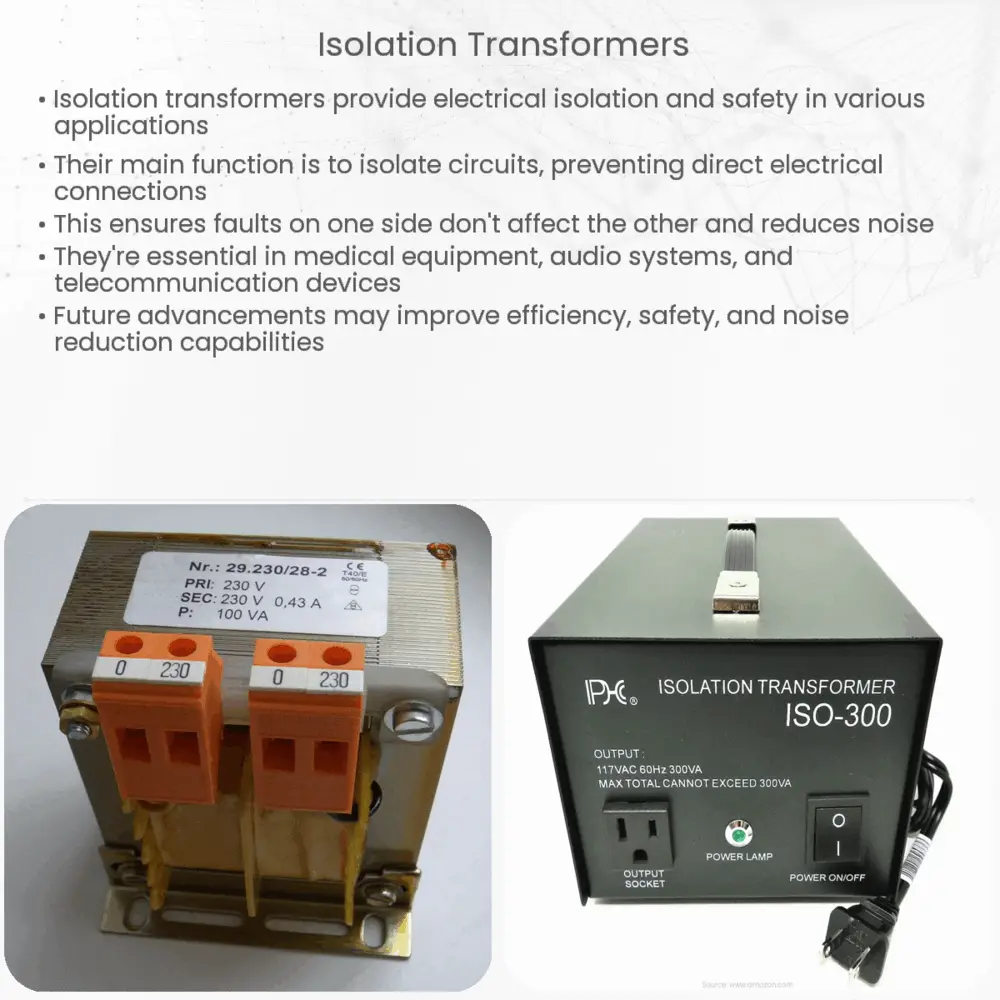Explore the fundamentals of isolation transformers, their types, and applications. Understand their construction, working principle, and future potential.

Understanding Isolation Transformers
At their core, isolation transformers are a specific type of transformer designed to provide electrical isolation and ensure safety in a variety of applications. They differ from standard transformers in their primary and secondary windings, which are separated to provide a high degree of electrical insulation.
Function and Benefits
The primary function of an isolation transformer is to isolate circuits, hence its name. It serves to prevent electrical and galvanic isolation between input and output, meaning that no direct electrical connection exists.
This isolation provides numerous benefits. Firstly, it ensures that an electrical fault on one side of the transformer does not immediately result in a fault on the other side. Secondly, it serves to reduce noise – that is, irregular fluctuations – by eliminating grounding loops, resulting in a more stable signal. Finally, it prevents electric shock hazards, safeguarding users and sensitive equipment.
Construction of Isolation Transformers
- Primary and Secondary Windings: The primary winding receives the input power while the secondary winding delivers the output. The isolation transformer is specially designed to separate these windings to provide electrical isolation.
- Insulation: An insulation barrier is used between the primary and secondary windings. This prevents a direct electrical connection and ensures safety and noise reduction.
- Core: The core of an isolation transformer is typically made from laminated silicon steel. It helps to contain and guide the magnetic field produced by the windings.
Application of Isolation Transformers
Isolation transformers find their applications in various areas due to their safety and noise reduction capabilities. They are especially useful in medical equipment, where they ensure safety and prevent ground loops. In addition, they are used in audio systems and telecommunication devices, where they help reduce humming noises caused by ground loops and maintain signal quality.
Furthermore, in power supply units, they ensure safety by isolating the device from the power source, and they find usage in data communication to prevent data loss or corruption due to noise.
The next part of the article will discuss in-depth the types of isolation transformers, working principles, and potential future developments in the field.
Types of Isolation Transformers
There are several types of isolation transformers designed to meet the specific requirements of various applications.
- Step-Up Isolation Transformers: These transformers increase voltage levels from the primary to the secondary side, ensuring compatibility with high-voltage equipment.
- Step-Down Isolation Transformers: As opposed to step-up transformers, these decrease voltage levels, making them suitable for low-voltage applications.
- Medical Isolation Transformers: Specially designed for medical applications, these transformers maintain high safety standards and prevent ground loops that could impact sensitive medical equipment.
- Audio Isolation Transformers: Used in audio devices, these transformers help reduce unwanted noise and maintain signal quality.
Working Principle of Isolation Transformers
The working principle of an isolation transformer is similar to a standard transformer. The main difference lies in the electrical isolation between the primary and secondary windings. When an AC voltage is applied to the primary winding, it generates a magnetic field. This field then induces a voltage in the secondary winding. Despite the electromagnetic transfer of power, there’s no electrical connection between the two windings, thereby ensuring electrical isolation.
Future of Isolation Transformers
The future of isolation transformers holds promise with potential advancements in both design and materials. As more sectors increasingly recognize the importance of electrical safety, the demand for isolation transformers is expected to rise. Advancements in materials may lead to transformers that are lighter, more efficient, and capable of handling higher frequencies, offering greater noise reduction capabilities. Furthermore, digital technologies may open up possibilities for smarter transformers that can diagnose and alert for any potential issues in real-time.
Conclusion
In conclusion, isolation transformers play a pivotal role in many sectors, including medical, telecommunications, audio systems, and power supply units. They provide electrical isolation, enhance safety, and reduce noise. As technology advances, we can anticipate continuous improvements in their efficiency, safety, and noise reduction capabilities, ensuring they remain integral components in our increasingly electrified world.


